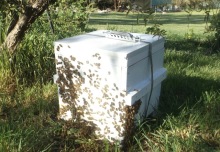Queen Bees are usually available from queen breeders each year from some time in October.
Hints for introducing queens
For high productivity, fewer swarms and gentle bees, regular requeening is recommended. Your queen will come from the breeder in a cage with some worker attendants, and some candy for food blocking one of the two entrances to the cage. The other entrance remains blocked when the cage is put in the hive.
1. The old queen in the hive should be killed, and the new queen can be introduced in the one operation. The old queen may be very difficult to find especially for new beekeepers.
2. The cage may be placed between combs in the brood nest, or on top of the frames over the brood nest, screen downwards. Some beekeepers spray the cage with sugar syrup or smear it with honey from the hive.
Note: At the meeting of the Beekeepers Association of the ACT on Wed 8 May 2002, Des Cannon, commercial beekeeper from Burra, suggested that, if the release of the queen is slowed, the queen is more likely to be accepted. If the queen is in a wooden cage with wire gauze, Des places the gauze face down over two sheets of unscented toilet paper on top of the brood frames and under the queen excluder. Presumably, the same effect can be obtained with a new plastic cage by wrapping it in the unscented toilet paper and placing it above the brood frames.
3. Leave the hive undisturbed for seven days.
Notes from the queen breeder
1. It is best to introduce the queens as soon as possible, but they should survive for about one week in the cage
2. The attendants will usually die first
3. If not introduced immediately, queens should be stored in a quiet dark place away from insecticides and given a drop only of water every few days in hot weather
4. It is best to introduce on a honey flow. If introducing in Autumn, make sure there is plenty of unsealed brood to ensure there are nurse bees capable of looking after the queen and feed the hive with sugar syrup. this is more important in autumn than Spring.
See also Requeening with a division board (no need to find the old queen?)
Hints on queen introduction by other beekeepers:
“What causes it [different opinions on methods of queen introduction] is the *fact* that no two hives behave exactly alike any more than any two people behave exactly alike. What works in beekeeping is *what usually works* or *what works most of the time* or even *what may work, if you are lucky*. Anyone who tells you he or she has a sure-fire method is got a case of inflated self importance.
Be ready to be fooled! The bees will switch the “rules” on you every time!
Queen introduction is an art, not a science. Success depends on weather, strains of bees, methods. In the middle of a honey flow you might be able to drop a strange queen right into a hive with no harm. With a very valuable queen I always introduce her to very young or emerging bees that don’t know any other queen.”
Peter Borst, BEE-L, Informed Discussion of Beekeeping Issues and Bee Biology, Mon, 18 Mar 2002
“The recommendation is to not put a hole in the candy end. The reasoning behind this is that the longer the bees take to release the queen the better the chance of acceptance. This is whether the hive was originally queen right or queenless.
We do not recommend looking at the hive before 7 days and then only with a minimum of smoke. If laying, take the cage out and leave.
FWIW.”
Trevor Weatherhead, AUSTRALIA, BEE-L, Informed Discussion of Beekeeping Issues and Bee Biology, Wed, 2 May 2001
Requeening savage hives
An easier way to requeen savage hives. Having inherited my share of savage bees here is my thoughts on how to make the job less unpleasant. This method assumes that the bees are in more than one box and have a queen excluder. You will need a spare floor and lid.
1 Remove supers and place spare lid on brood box.
2 Place brood box to one side. I suggest about 5 meters depending how savage the bees are.
3 Reassemble supers on spare floor in original position
4 Leave for at least 20 minutes this lets the field bees leave the brood box and fly back to the supers.
5 Requeen
6 Reassemble the hive as it originally was.
Also I have found it easier to see the queen on bright sunny days
Regards Don Nairn by email 19 July 2002″


 Like us on Facebook
Like us on Facebook